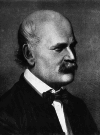Pioneering Hand Hygiene: Ignaz Semmelweis and the Fight Against Puerperal Fever
- PMID: 39553012
- PMCID: PMC11568873
- DOI: 10.7759/cureus.71689
Pioneering Hand Hygiene: Ignaz Semmelweis and the Fight Against Puerperal Fever
Abstract
Hungarian physician Ignaz Semmelweis (1818-1865) revolutionized medical practice through his introduction of antiseptic procedures. This breakthrough disrupted the chain of infection among new mothers and their infants, leading to dramatically reduced mortality rates from puerperal fever across continental Europe. Semmelweis faced significant resistance and disbelief when he argued through meticulous, empirically-based evidence that proper hand hygiene may prevent infection. Semmelweis' pioneering work on infection prevention remains highly relevant even today, as evidenced by contemporary practices aimed at controlling the spread of disease and improving patient safety through improved hygiene. In this article, we look into the key moments in Semmelweis's life that led to his revolutionary discoveries as well as oppositions against them and his lasting impact on modern medicine.
Keywords: antiseptic procedures; chlorinated lime; germ theory; hand hygiene; historical vignette; ignaz semmelweis; infection control; maternal mortality; medical innovation; puerperal fever.
Copyright © 2024, Paul et al.
Conflict of interest statement
Conflicts of interest: In compliance with the ICMJE uniform disclosure form, all authors declare the following: Payment/services info: All authors have declared that no financial support was received from any organization for the submitted work. Financial relationships: All authors have declared that they have no financial relationships at present or within the previous three years with any organizations that might have an interest in the submitted work. Other relationships: All authors have declared that there are no other relationships or activities that could appear to have influenced the submitted work.
Figures
Similar articles
-
Rediscovering Ignaz Philipp Semmelweis (1818-1865).Am J Obstet Gynecol. 2019 Jan;220(1):26-39. doi: 10.1016/j.ajog.2018.11.1084. Epub 2018 Nov 13. Am J Obstet Gynecol. 2019. PMID: 30444981
-
A twenty-first century perspective on concepts of modern epidemiology in Ignaz Philipp Semmelweis' work on puerperal sepsis.Eur J Epidemiol. 2022 May;37(5):437-445. doi: 10.1007/s10654-022-00871-8. Epub 2022 Apr 29. Eur J Epidemiol. 2022. PMID: 35486338 Free PMC article. Review.
-
Medicine in stamps-Ignaz Semmelweis and Puerperal Fever.J Turk Ger Gynecol Assoc. 2013 Mar 1;14(1):35-9. doi: 10.5152/jtgga.2013.08. eCollection 2013. J Turk Ger Gynecol Assoc. 2013. PMID: 24592068 Free PMC article. Review.
-
From septicemia to sepsis 3.0 - from Ignaz Semmelweis to Louis Pasteur.Microbes Infect. 2019 Jun-Jul;21(5-6):213-221. doi: 10.1016/j.micinf.2019.06.005. Epub 2019 Jun 27. Microbes Infect. 2019. PMID: 31255674
-
[Semmelweis - a contemplating human. Scientific historical lessons].Orv Hetil. 2018 Jul;159(26):1055-1064. doi: 10.1556/650.2018.31174. Orv Hetil. 2018. PMID: 29936856 Hungarian.
References
-
- Germ theory: contagion. Curiosity digital collections. [ Sep; 2024 ]. 2020. https://curiosity.lib.harvard.edu/contagion/feature/germ-theory https://curiosity.lib.harvard.edu/contagion/feature/germ-theory
-
- Semmelweis: The combat against puerperal fever. Adriaanse AH, Pel M, Bleker OP. https://pubmed.ncbi.nlm.nih.gov/10825634/ Eur J Obstet Gynecol Reprod Biol. 2000;90:153–158. - PubMed
-
- Speert H. Philadelphia: F.A. Davis Company; 1973. Iconographia Gyniatrica. A Pictorial History of Gynecology and Obstetrics.
Publication types
LinkOut - more resources
Full Text Sources
Research Materials

